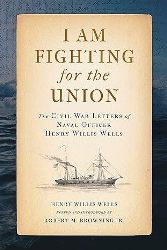 Pirates and Privateers Pirates and Privateers
The History of Maritime
Piracy
Cindy Vallar, Editor
& Reviewer
P.O. Box 425,
Keller, TX 76244-0425
    
Books for
Adults ~ History: Navy (United States)

I Am Fighting for the Union: The Civil War Letters of
Naval Officer Henry Willis Wells
by Henry Willis Wells
edited by Robert M. Browning, Jr.
University of Alabama, 2023, ISBN 978-0-8173-6105-1,
US $34.95
Also available in other formats
    
In August 1862,
twenty-year-old Henry Willis Wells joined
the United States Navy. His rank was
master’s mate, a position that placed him
between higher-ranking officers and
seamen. Several months after volunteering
to serve, he explained to his mother that
“I am fighting for the Union,” and he
believed that serving his country was
important during this time of conflict
between the North and the South. (ix)
He did not enter the navy as a novice; his
first sailing venture took him to the West
Coast aboard a clipper ship at the age of
fifteen. Between subsequent cruises in the
merchant marine, he studied navigation at
Boston Mercantile and Nautical College to
add to his nautical knowledge learned at
sea. His first posting in the navy saw him
serving as an acting master’s mate aboard
the Cambridge, a steam vessel that
had previously seen duty as a merchantman.
The ship was part of the North Atlantic
Blockading Squadron. He would serve on
other vessels that patrolled waters off
North Carolina and the Florida Coast,
including Key West, and several months
before his death, he was finally given his
own commands, first the US Sloop Rosalie
and then US Schooner Annie.
Throughout his journeys, Henry wrote
letters home, many of which survive and
were first gathered together by his
great-nephew. Now they have been published
in chronological sequence as part of the
University of Alabama’s Maritime Currents:
History and Archaeology series, for
readers and historians interested in the
day-to-day life of a junior naval officer
during the American Civil War. These
missives provide personal glimpses into
the men he served with and what transpired
on each voyage from his entry into the
navy until his death in December 1864.
Also included are occasional official
documents, such as orders and notices of
his brief capture by Confederate forces
and his death. Browning includes maps, a
timeline of events in Henry’s naval
career, and period illustrations
(including a map that Wells drew of Union
defenses at Washington, North Carolina).
Notes, which explain or elaborate on
details found in the letters, are also
included, as are a bibliography and an
index.
Among the war-related news that Henry
shared are what he witnessed on day one of
the Battle of Hampton Roads, chasing
blockade runners, sleeping arrangements
aboard his ships, interactions with
contraband (escaping slaves) and prisoners
of war being exchanged, participation on
court-martials, and the effects of
illnesses on himself and others.
Even though the letters shared are only
his, readers still get to learn about his
family and homelife during the war. Most
missives are addressed to his mother, but
he also wrote to his father, sisters, and
cousin, Louisa May Alcott. There are
several poignant stories, including one of
a Rebel prisoner who shows Henry a Bible
that saved his life or the wounded soldier
who was sitting by an ambulance when
guerrillas murdered him. There are
requests for specific items in care
packages and feelings of homesickness when
he fails to hear from those he loves.
In addition, he shares personal opinions
and thoughts on subjects pertinent to the
time or his family, allowing readers to
experience these from a 19th-century
perspective. Although he volunteered to
serve, he was not classified as regular
navy personnel because his experience came
more from firsthand knowledge rather than
formal education by the navy. This
resulted in encounters where prejudice and
bias were prickly thorns for him, as was
his age which was given as one reason for
his not being promoted even though he was
better qualified for advancement than
others with whom he served. Even so, this
inquisitive and determined young man
eventually achieved his goal of promotion
and command.
This is a highly enlightening volume that
provides readers with eyewitness
perspectives of what it was like to serve
in the Union navy during the Civil War. If
there is any drawback to this volume, it
is the location of the notes. Rather than
inserting the relevant information on the
bottom of the pages where the mention is
made or at the end of particular letters,
the notes are found after the
correspondence ends. This necessitates
that the reader flip back and forth, which
most will not do, and some of the endnote
numbers are difficult to see, which means
the reader may miss that there is
additional information or explanations
that are relevant.
Review Copyright ©2023 Cindy Vallar

Click to contact me
Background image compliments
of Anke's Graphics |

